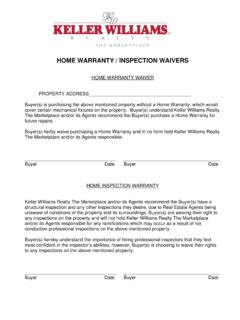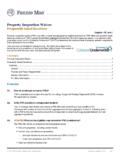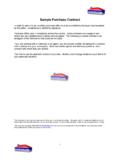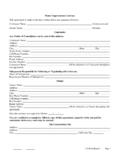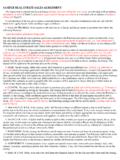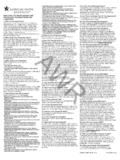Transcription of BY ORDER OF THE COMMANDER AIR FORCE INSTRUCTION …
1 BY ORDER OF THE COMMANDER 21ST SPACE WING AIR FORCE INSTRUCTION 21-101 21ST SPACE WING Supplement 18 OCTOBER 2016 Maintenance AIRCRAFT AND EQUIPMENT MAINTENANCE MANAGEMENT COMPLIANCE WITH THIS PUBLICATION IS MANDATORY ACCESSIBILITY: Publications and forms are available for downloading or ordering on the e-Publishing website at RELEASABILITY: There are no releasibility restrictions on this publication OPR: 21 OSS/MA Supersedes: AFI 21-101_21 SWSUP, 13 Nov 2012 Certified by: 21 OSS/CC (Lt Col Mark Hauser) Pages: 12 This INSTRUCTION implements and extends the guidance of Air FORCE INSTRUCTION (AFI) 21-101, Aircraft and Equipment Maintenance Management. It provides guidance and procedures to effectively develop and manage a Crashed, Damaged, or Disabled Aircraft Recovery (CDDAR) program, a Tool Control program, a Foreign Object Damage (FOD) prevention program, and a Dropped Object Prevention (DOP) program.
2 This supplement provides procedures governing aerospace equipment maintenance management and applies to all assigned, attached or associated units of Peterson AFB that maintain aircraft, aircraft systems, equipment, support equipment, and components. This publication applies to Air FORCE Reserve Command (AFRC) Units and does not apply to Air National Guard Units. Tenant units (302 Airlift Wing, 200 Airlift Squadron, and 98 Flying Training Squadron) comply with support agreements as applicable. Refer recommended changes and questions about this publication to the Office of Primary Responsibility (OPR) using the AF 847, Recommendation of Change of Publication; route AF 847s from the field through the appropriate functional chain of command. The authorities to waive wing/unit level requirements in this publication are identified with a Tier (T-3) number following the compliance statement.
3 See AFI 33-360, Publications and Forms Management, for a description of the authorities associated with the Tier numbers. Submit requests for waivers through the chain of command to the appropriate Tier waiver approval authority, or alternately, to the Publication OPR for non-tiered compliance items. Ensure that all records created as a result of processes prescribed in the publication are maintained in accordance with AFMAN 33-2 AFI21-101_21 SWSUP 18 OCTOBER 2016 363 Management of Records and dispose of in accordance with Air FORCE Records Information Management System (AFRIMS) and the Air FORCE Records Disposition Schedule. This publication may not be supplemented. SUMMARY OF CHANGES This document has been substantially revised and needs to be completely reviewed in its entirety. It has been revised in an effort to be more directive in nature providing the user a clear picture of responsibilities. (Added) Any transient aircraft requiring maintenance outside the scope of Transient Alert (TA) requires the aircrew to contact their home unit to send a Maintenance Recovery Team.
4 (Added) The Maintenance Officer/Superintendent, Wing Safety Representative, or a Federal Aviation Administration (FAA) representative would make the determination if the aircraft should be impounded. IMPORTANT: No maintenance actions are accomplished without the concurrence of the impoundment official. The impoundment official for aircraft not assigned/attached to Peterson AFB is designated from the home station of the aircraft. The impoundment is released to the maintenance team chief of the owning organization upon the team s arrival. (Added) Personnel that use tools/equipment on the flightline, on aircraft, or on Aerospace Ground Equipment (AGE) or maintain support equipment that is used on aircraft or on the flightline are required to use an accountability system IAW chapter 1, chapter 8 and chapter 11 of this INSTRUCTION . (Added) Tools, equipment, and CTKs are secured and controlled in a manner as to prevent access or use without proper accountability.
5 (Added) Tools are accounted for at all times and secured when not in use. All units that do not utilize an approved tool accountability system are required to develop an Operating INSTRUCTION (OI) to account for and control tools used on the flightline or in a maintenance industrial area. Consolidated Tool Kit (CTK) monitor, maintain a list of all warranty tools and ensure broken or damaged warranty tools are isolated and under strict control until replaced. (Added) Units possessing tools under warranty that were procured from a manufacturer other than Snap-On should contact that manufacturer directly for instructions on replacing unserviceable tools. (Added) Purchase tools that are covered by a warranty and supports easy replacement at no additional cost to the government. (Added) Hazardous material, consumable and expendable items (batteries, safety wire, adhesive, solder, hacksaw blades, drill bits, etc.)
6 May be placed in a CTK, and be added to the Master Inventory List. Note: These tools are used to replace broken, worn, or missing tools to prevent unnecessary work delays. Enforce strict control of these items and replace on a one-for-one basis. AFI21-101_21 SWSUP 18 OCTOBER 2016 3 (Added) Expendable hand tools such as blades, apexes, files, and file cleaners consumed during use may be placed on bench stock. Personnel conduct and document a joint inventory of all tools if a transfer is required at the job site. (Added) Report missing or lost tools immediately to supervision. Follow and document procedures identified in paragraph , lost item/tool procedures. All individual Personal Protective Equipment ( , ear protectors, reflective belts, and headsets) are controlled and marked with an identifier that easily distinguishes the owner to include first name initial, last name, and employee number (if applicable).
7 (Added) Rags that leave the CTK area are controlled at all times. Note: Issue rags on a one-for-one swap or in pre-packaged containers with the number of rags clearly marked on each container. The number of personnel authorized to procure tools are kept to a minimum ( , a primary and alternate). Local manufactured or developed tools are marked and controlled in the same manner as any other tool in the CTK. Depot field teams, field service representatives, and contract field teams need to be monitored to ensure positive tool accountability when working on equipment within the unit. Emergency response equipment ( , CDDAR and hydrazine response equipment) that is stored outside of the controlled tool room is kept secured and issued when needed. (Added) All CTKs are required to have a second party signature when signing a CTK back into the tool room. Access to tool rooms is kept to a minimum Note: ( , only individuals required/authorized to issue/turn-in or inspect equipment).
8 (Added) Personal electronic devices are permitted only for the purpose of conducting official business when on the flightline. (Added) Personnel that work in, on, around, or travel through areas near aircraft or AGE are required to comply with FOD prevention measures. (Added) Remove and secure Restricted Area Badges (RAB)/pass when within 25 feet of operating engine(s). Line badges/passes completely secured inside of an armband pouch do not need to be removed. (Added) Personnel can wear hats on the flightline, but remove them when aircraft are operating in close proximity. During cold weather, the black watch cap/ski mask and ABU watch cap or micro fleece hats are authorized. These hats can be worn within 50 feet of running engines ONLY if secured by ear defenders or a ground communication headset. (Added) Security Forces personnel while performing official duties may wear the beret without insignia attached; however, when they are within 50 feet of an operating aircraft removed and secured berets.
9 Note: If Security Forces are wearing Kevlar helmets, the chinstraps needs be secured. 4 AFI21-101_21 SWSUP 18 OCTOBER 2016 (Added) All flightline vehicles are required to be equipped with a suitable covered FOD container. Note: Storage containers on tugs and in tractors may be used in place of self-closing containers. Secure containers so as not to tip over when vehicle is in motion. (Added) Airfield Management ensure flightline driver s training program stresses the importance of FOD prevention, control of vehicles on the flightline, and precautions to be taken prior to driving onto the airfield hard surfaces from unpaved areas. (Added) Vehicle operators (including contractors) inspect the cab interior, cargo bed area, and tires prior to use and remove all foreign material that could inadvertently fall on the airfield, creating a potential FOD hazard. (Added) Vehicle operators attempt to enter the military aircraft-parking ramp via paved surfaces using flightline gate entrances.
10 (Added) All vehicles should only be driven on clean, paved surfaces. If a vehicle is forced to depart the paved surface for any reason, perform a FOD check before entering the flight line to ensure no foreign objects ( rocks or stones, etc.) are tracked onto the ramp. (Added) Emergency response vehicles responding to an In Flight Emergency (IFE)/Ground Emergency perform a vehicle FOD inspection as time permits. (Added) If a FOD check was not accomplished prior to entering the flight line, accomplished at the predetermined staging area. Once staged and time permitting, all vehicles perform a tire rollover check. Note: If time does not permit ( , aircraft has already landed) a FOD check is then accomplished after IFE terminates and before returning to station. (Added) Airfield Management coordinate with 21 CES (Civil Engineer Squadron) and 21 CONS on areas where construction is in progress and confirm requests for sweeper operations by contractors promptly during operating hours.










